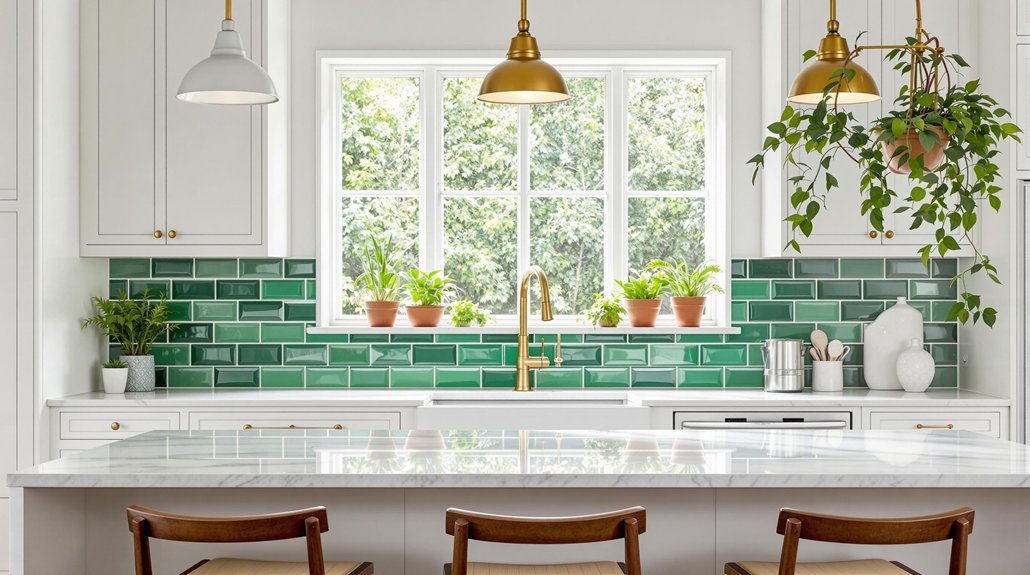
15 White Kitchen With Green Tile Ideas That Add Natural Beauty
White kitchens with green tile infuse natural vibrancy and elegance into culinary spaces. Expertly balanced, options range from minimalist white cabinetry paired with herringbone or emerald subway tiles, to contemporary layouts using sage or deep forest hues for organic warmth. Textured and patterned tiles enhance depth and light, while contrasting hardware introduces refined structure. Carefully chosen palettes guarantee color cohesion and spatial harmony. Exploring diverse configurations reveals which pairings maximize both beauty and function in any kitchen design.
Key Takeaways
- Pairing classic white cabinetry with green subway or herringbone tiles creates a fresh, nature-inspired focal point in any kitchen.
- Glossy green ceramic or zellige backsplashes reflect light, adding depth and visual intrigue while amplifying a kitchen’s natural beauty.
- Incorporating organic materials like wood accents and stone countertops grounds the design, enhancing warmth and inviting ambiance.
- Open shelving with green-tiled backdrops allows display of plants or ceramics, seamlessly blending style and natural elements.
- Contrasting hardware in matte black or brass elevates the space, providing modern structure against white cabinets and vibrant green tiles.
Minimalist White Kitchen With Green Herringbone Tiles
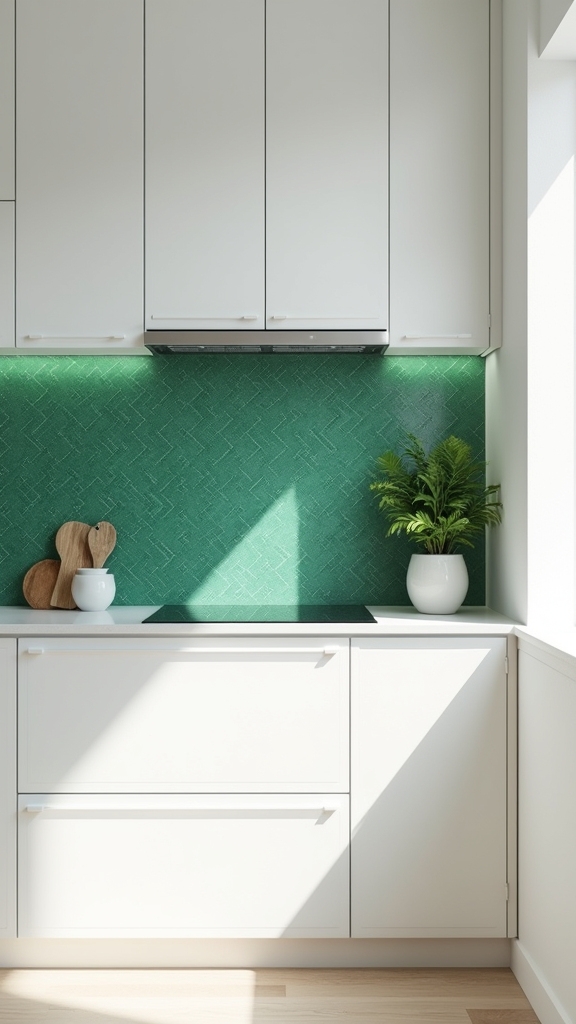
While prioritizing clean lines and uncluttered surfaces, a minimalist white kitchen achieves visual intrigue through the strategic use of green herringbone tiles as a backsplash. The crisp contrast between the pristine cabinetry and the saturated green tiles enhances minimalist aesthetics, balancing simplicity with refined detail. The herringbone pattern introduces dimensional texture, breaking the planar monotony typical to minimalist spaces, while also enhancing the perception of depth within the kitchen’s spatial envelope. High-quality materials, inspired by Scandinavian sensibilities, contribute to an atmosphere rooted in both function and visual clarity. Incorporating green herringbone tiles not only punctuates the white kitchen with color but also integrates natural elements, echoing current trends toward organic inspiration. This approach results in a space that is at once functional, elegant, and visually compelling. Greige cabinets seamlessly blend with various design styles, ensuring timeless appeal.
Modern Galley Kitchen Featuring Green Ceramic Backsplash
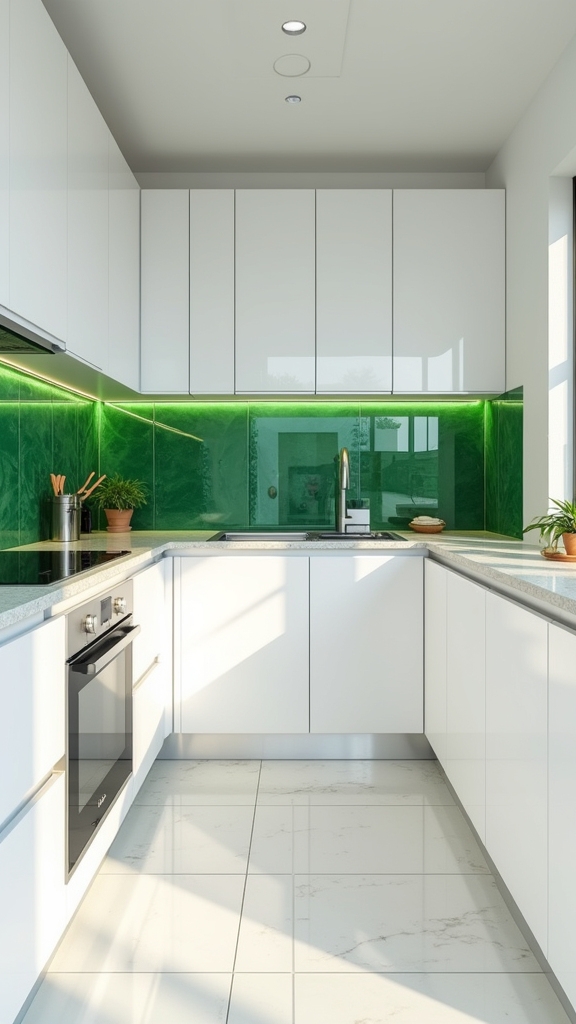
Emphasizing the interplay between spatial efficiency and striking visual elements, a modern galley kitchen benefits from the introduction of a green ceramic backsplash against crisp white cabinetry.
The green ceramic backsplash provides a compelling visual focal point, its glossy finish amplifying natural and artificial light to visually expand the narrow footprint typical of galley layouts. The integration of modern design principles is further reinforced through the flexibility of tile arrangement, enabling homeowners to select patterns that reflect personal style while maintaining coherence with white cabinetry.
A glossy green ceramic backsplash brightens galley kitchens, creating visual depth while allowing for personalized patterns alongside timeless white cabinetry.
Additionally, the practical aspects of green ceramic—its durability and ease of maintenance—make it an ideal selection for high-traffic culinary environments.
- Reflective surfaces enhance ambient lighting
- Customizable tile patterns express individuality
- Harmonizes with natural materials for warmth
- Durable backsplash simplifies cleaning routines
Classic White Cabinets Paired With Emerald Subway Tiles
Pairing classic white cabinetry with emerald subway tiles establishes a timeless color scheme that balances neutrality with bold visual interest. The glossy green backsplash becomes an immediate focal point, introducing depth and vibrancy without overwhelming the space. For added sophistication, contrasting hardware in matte black or brushed brass punctuates the design, enhancing both dimension and cohesion. Gold hardware remains a popular choice in kitchen design, seamlessly integrating with various color schemes and adding a touch of luxury.
Timeless Color Pairing
Since classic white cabinetry establishes a luminous and open foundation, emerald subway tiles emerge as a striking focal point that introduces depth and sophistication to the kitchen.
This timeless color pairing leverages the reflective quality of high-gloss emerald tiles, amplifying light and invigorating the space with a dynamic visual effect.
The interplay between classic white and emerald subway tiles enables seamless integration of natural materials, such as warm wood accents or honed stone countertops, for layered organic beauty.
This versatile combination supports both contemporary and traditional aesthetics by balancing modernity with enduring appeal.
Design professionals recommend considering the following:
- Herringbone or stacked tile patterns for modern flair
- Wood shelving or trim for warmth and texture
- Stone or quartz countertops to ground the palette
- Under-cabinet lighting to highlight tile brilliance
Vibrant Backsplash Focus
How does one achieve a kitchen design that feels both invigorating and timeless? The answer lies in the strategic pairing of emerald subway tiles with classic white cabinetry. This approach transforms the backsplash into a vibrant focal point, drawing the eye while establishing a fresh, modern aesthetic.
The glossy surface of emerald subway tiles amplifies light, fostering a sense of spaciousness and enhancing the kitchen’s overall luminosity. White cabinetry acts as a neutral anchor, ensuring the bold green hue remains sophisticated and balanced.
This interplay of color and finish allows seamless integration with a spectrum of countertop materials, including marble and quartz, further elevating the kitchen’s luxury quotient. Ultimately, the emerald tiles infuse the space with natural beauty, evoking lush, organic inspiration.
Contrasting Hardware Accents
Building on the dynamic interplay between classic white cabinetry and emerald subway tiles, the selection of contrasting hardware accents introduces an additional layer of refinement and visual structure.
Contrasting hardware, such as matte black or burnished brass, punctuates the white cabinets, drawing the eye and grounding the vibrant backsplash design. The reflective surface of emerald subway tiles amplifies light, while the hardware’s finish establishes tactile and visual balance within the space.
Strategic placement of these accents not only enhances the kitchen’s spatial rhythm but also bridges classic and contemporary aesthetics. For a cohesive look, consider the following pairings:
- Matte black pulls on white cabinets for modern contrast
- Brushed brass knobs complementing emerald subway tiles
- Mixed metal hardware to add eclectic sophistication
- Linear handles echoing herringbone backsplash patterns
Contemporary Open Plan Kitchen With Sage Green Accents
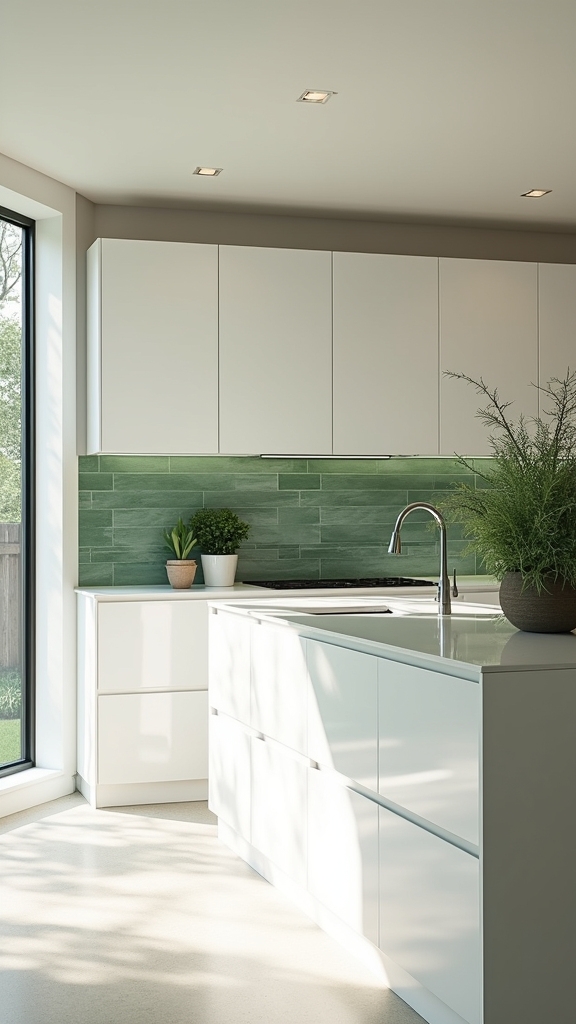
When executed with an expert eye for spatial harmony, a contemporary open plan kitchen featuring sage green accents achieves a balance between modern minimalism and organic warmth. Sage green tiles, strategically applied as a backsplash or accent wall, inject a measured dose of color, enhancing the pristine effect of white cabinetry. Open shelving, a hallmark of the contemporary kitchen, serves both function and form—providing display opportunities for curated greenery or artisanal ceramics that amplify the botanical undertones of sage. The integration of natural materials such as timber or stone further grounds the design, fostering a tactile connection to nature. Soft muted tones create tranquility and spaciousness, while vibrant options add energy, impacting the kitchen’s mood. Expansive windows or open layouts bathe the space in natural light, intensifying the calming effect of sage green while preserving the kitchen’s light, airy character.
Mid-Century Style Kitchen With Lime Green Tile Details
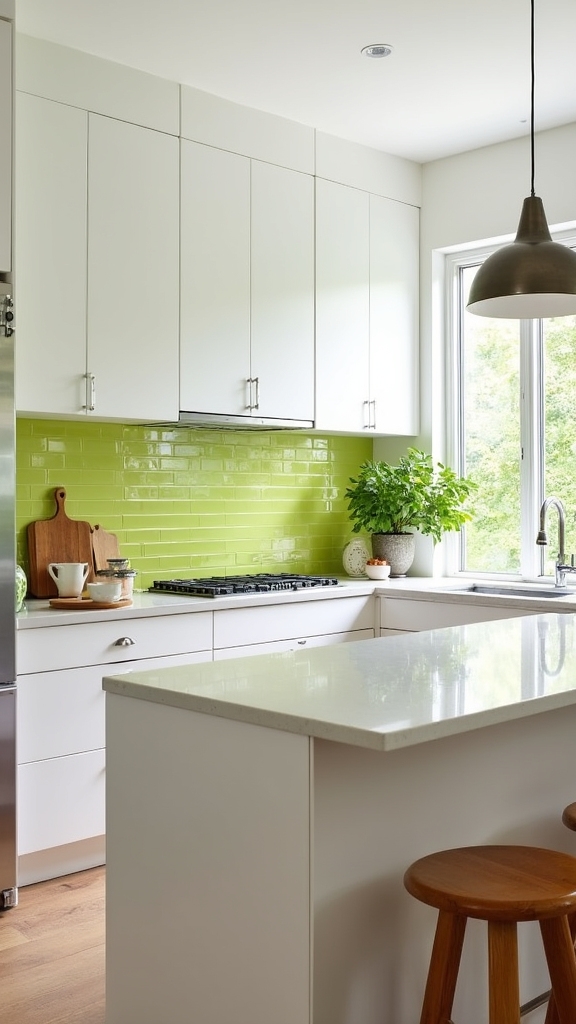
Striking a vivid chord between nostalgia and modernity, a mid-century style kitchen comes alive through the introduction of lime green tile details.
The crisp juxtaposition of lime green tiles against white cabinetry establishes a spatial harmony that accentuates both color and form. Sleek lines and minimalistic silhouettes, characteristic of the mid-century style kitchen, are further enhanced by the strategic use of green tiles as backsplashes or accent walls.
The interplay of natural beauty and vibrant color energizes the kitchen while maintaining an inviting ambiance. Expertly layered textures—ranging from glossy to matte tile finishes—add dimension without overwhelming the senses. Warm wood accents, often integrated in shelving or trim, reinforce the era’s organic sensibility.
- Lime green backsplash for color pop
- White cabinetry for clean contrast
- Wood accents for warmth
- Glossy or matte tiles for textural depth
Shaker Cabinets and Glossy Green Tile Splashback
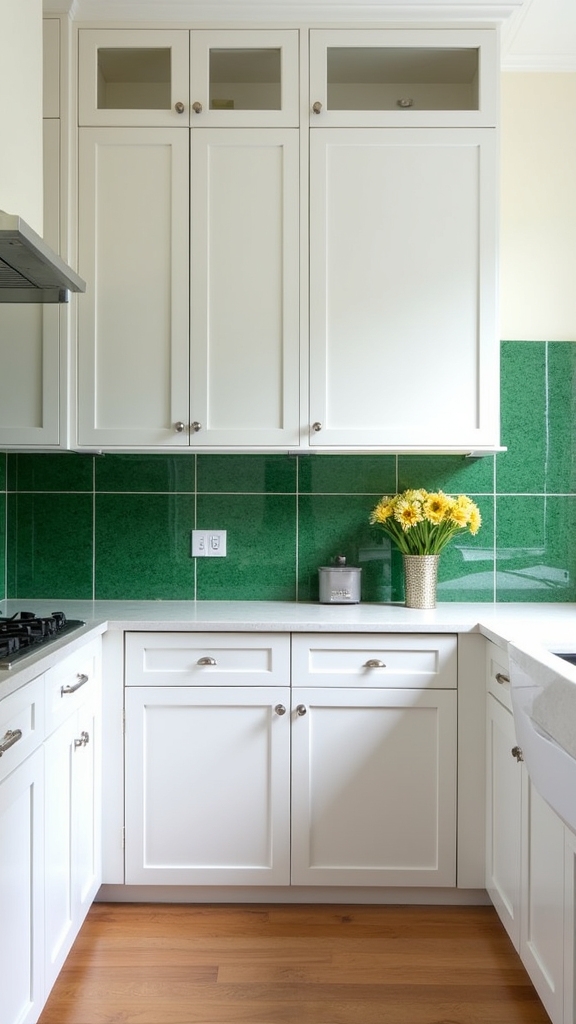
Balancing timeless form with contemporary flair, shaker cabinets paired with a glossy green tile splashback offer a dynamic approach to white kitchen design.
The clean lines and understated profiles of shaker cabinets create a structured foundation, while the reflective quality of glossy green tile infuses the space with vibrancy and visual depth.
The tile splashbacks introduce an energizing pop of color, contrasting elegantly with the crispness of a white kitchen and preventing a clinical appearance.
This combination fosters cohesion—shaker cabinets ground the design in tradition, while glossy green tile provides modern freshness.
The interplay of matte cabinetry and lustrous tiles enhances spatial awareness, making the kitchen feel brighter and more expansive.
Ultimately, this pairing achieves sophistication and a subtle nod to organic inspiration.
Small White Kitchen With Stacked Green Mosaic Tiles
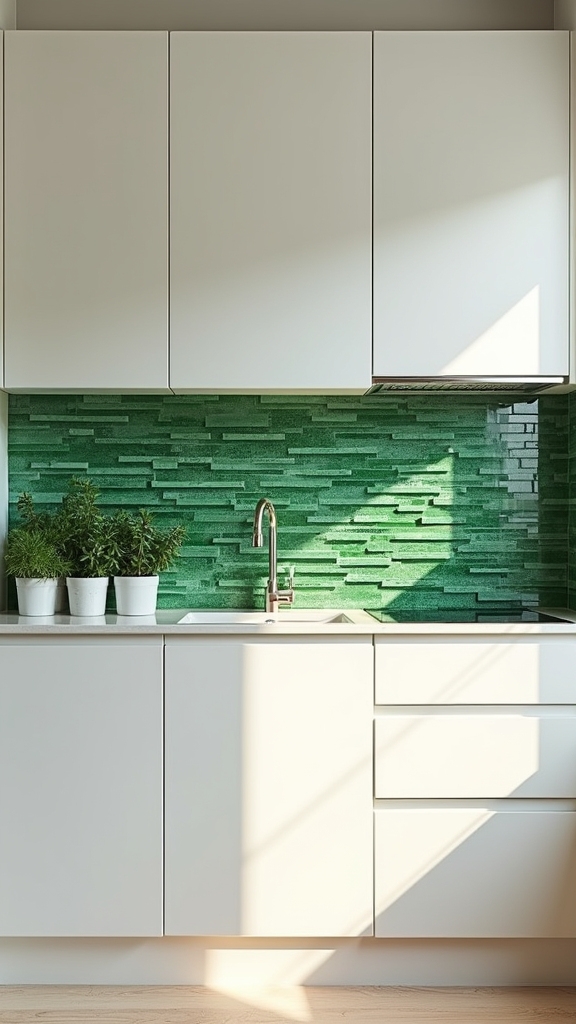
In compact white kitchens, stacked green mosaic tiles serve as both a strategic color accent and a visually engaging focal point.
The interplay of varied green hues and reflective surfaces optimizes light distribution, contributing to a sense of expansiveness.
Careful placement of these mosaics behind work zones or along key sightlines enhances spatial definition while maintaining an uncluttered aesthetic.
Maximizing Space With Color
Although compact kitchens often present spatial challenges, a strategic palette can transform perceived dimensions and atmosphere. In the context of small kitchen design, maximizing space with color becomes paramount.
A white kitchen green motif, highlighted by a stacked green mosaic tile backsplash, leverages color theory and spatial illusion to its advantage. The interplay of crisp white cabinetry with carefully chosen green tiles introduces depth, vibrancy, and an organic freshness.
Vertical placement of mosaic tiles visually elongates walls, making limited areas feel taller and less confined. Glossy tile finishes further amplify ambient light, enhancing openness.
- Vertical green tile backsplash visually heightens the room
- Small mosaic patterns add interest without visual clutter
- Glossy tile surfaces reflect light for increased brightness
- White and green palette maintains a cohesive, airy aesthetic
Mosaic Tiles as Focal
Focalization through stacked green mosaic tiles redefines the visual hierarchy of a small white kitchen. By employing mosaic tiles as an accent wall or backsplash, designers introduce a concentrated burst of color that enlivens the space without overwhelming its compact footprint.
The inherent intricacy of mosaic tiles offers layered patterns and tactile dimension, juxtaposed against the crisp minimalism of white cabinetry. This interplay not only amplifies visual interest but also leverages the reflective properties of green tiles, optimizing natural and artificial light for a brighter, more expansive feel.
Customizable in shade and arrangement, green tiles allow tailored cohesion with existing surfaces and finishes. Strategically placed, these mosaic installations infuse natural vibrancy, transforming the accent wall into a curated focal point within the white kitchen.
Scandinavian-Inspired Kitchen With Muted Green Zellige
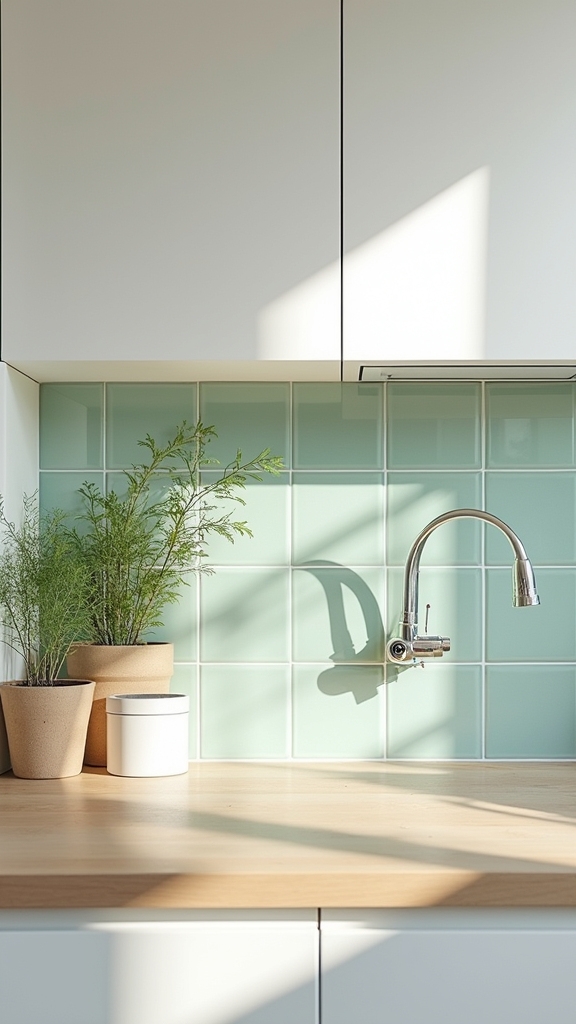
A Scandinavian-inspired kitchen featuring muted green zellige tiles exemplifies the principles of minimalism and functionality, central to Nordic design.
The handmade zellige tiles, with their subtle gloss and artisanal texture, introduce nuanced visual depth against the backdrop of white cabinetry. Muted green tones evoke serenity and establish a seamless connection to nature, a hallmark of Scandinavian design.
The interplay of natural materials and refined surfaces enhances spatial clarity, ensuring the kitchen feels both open and inviting while maintaining practical efficiency.
- Muted green zellige tiles deliver a gentle color infusion without overwhelming the space
- White cabinetry underscores the minimalist ethos and maximizes reflected light
- Artisanal craftsmanship of zellige tiles offers tactile richness and visual interest
- Natural elements and clean lines preserve the functional, organic character of Scandinavian design
Farmhouse Kitchen With High-Gloss Green Subway Tiles
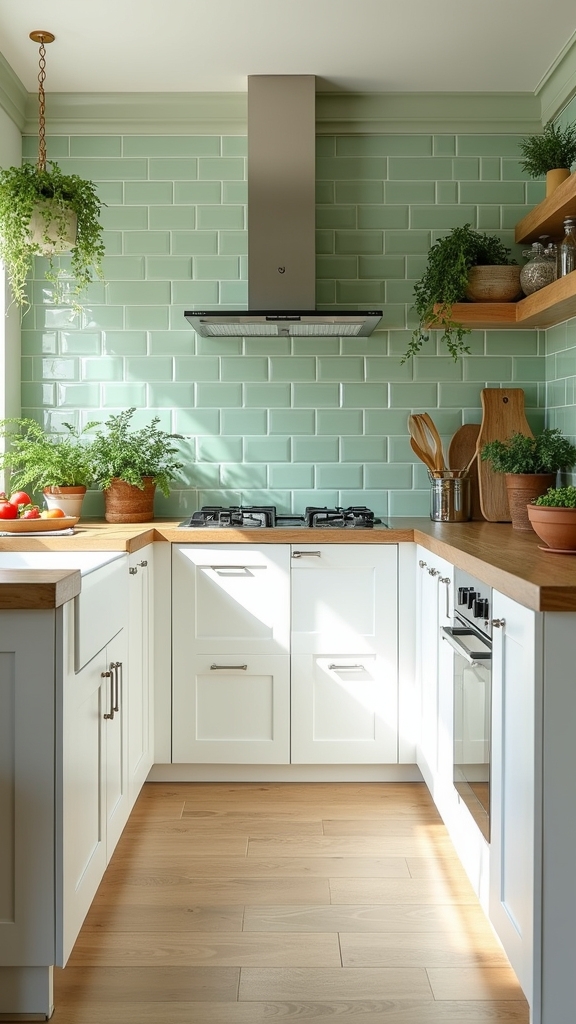
Vivid contrast defines a farmhouse kitchen where high-gloss green subway tiles serve as a luminous focal point against crisp white cabinetry.
The reflective qualities of the high-gloss finish amplify ambient and natural light, contributing to a brighter, more expansive spatial perception. White cabinetry anchors the scheme, providing a clean backdrop that accentuates the vibrant hue and gloss of the tiles.
High-gloss tiles enhance light and space, while white cabinetry highlights their vivid color and shine for a striking kitchen effect.
Integrating warm wood accents further grounds the space, preserving the inviting essence of farmhouse style. For a modern touch, black cabinet hardware introduces a subtle edge, bridging traditional elements with contemporary sensibilities.
The high-gloss green subway tiles are not only visually compelling but also highly practical, offering easy maintenance suitable for active kitchens. This combination aligns seamlessly with current trends favoring bold color and tactile finishes.
White Kitchen Island With Contrasting Forest Green Tiles
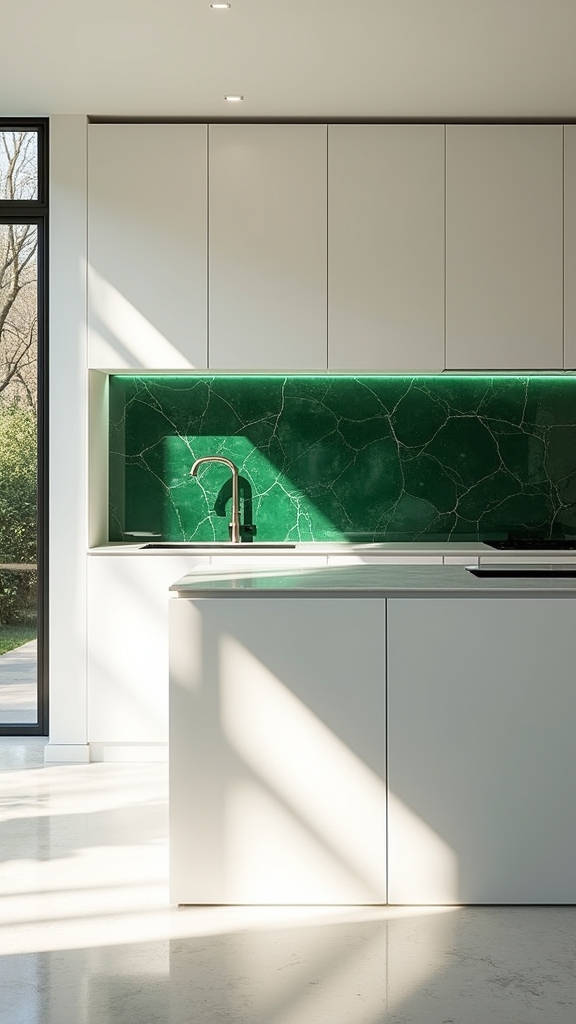
A white kitchen island punctuated by forest green tiles introduces a high-contrast visual anchor within the space, immediately drawing attention to the island as a design centerpiece.
The interplay between crisp white cabinetry and the saturated green hue establishes a cohesive color palette that balances vibrancy and serenity.
Strategic placement of textured or glossy forest green tiles further amplifies spatial depth, ensuring the kitchen remains both visually dynamic and harmoniously unified.
Forest Green Tile Contrast
When forest green tiles are introduced as a contrasting element to a white kitchen island, the result is a sophisticated focal point that anchors the overall composition.
This strategic use of color contrast leverages the depth and richness of forest green tiles to enhance the crisp brightness of white cabinetry. The juxtaposition not only delivers a striking visual focal point but also infuses the kitchen with a sense of tranquility and organic appeal.
Integrating natural materials such as wood or stone further raises the connection to nature, ensuring the design remains cohesive and visually inviting.
For a balanced and timeless outcome, consider:
- Forest green tile backsplash framing the white island
- Rich green accent tiles against pristine white cabinetry
- Natural materials complementing the color palette
- Purposeful placement to heighten spatial awareness
Island Design Highlights
By juxtaposing crisp white cabinetry with the saturated tones of forest green tiles, the kitchen island emerges as a deliberate focal point within the spatial layout.
This contrast leverages the inherent luminosity of white surfaces, allowing the depth and vibrancy of the forest green tiles to command visual attention.
Employing glossy tiles on the island’s backsplash or as vertical accents can amplify light reflection, contributing to both functional illumination and aesthetic intrigue.
For an enhanced tactile experience, designers may specify textured or patterned forest green tiles, introducing a dynamic interplay alongside the minimalist silhouette of the white cabinetry.
This strategic pairing not only enhances the kitchen island’s prominence but also fosters seamless integration with natural elements, reinforcing the kitchen’s contemporary yet organic ambiance.
Cohesive Color Palette
Harmony between materials and hues defines the success of a contemporary kitchen, particularly when a white island is juxtaposed with forest green tiles. This striking interplay creates a cohesive color palette, essential for modern kitchen designs seeking both visual depth and spatial balance.
White cabinetry serves as a crisp, neutral backdrop, amplifying the richness of forest green tiles and ensuring the space feels open yet anchored. Varying tile shades and finishes—such as glossy or textured—add further dimension, allowing for nuanced light reflection and enhanced tactile interest.
The overall effect is a kitchen environment that feels fresh, organic, and inviting. Key strategies for achieving this cohesive look include:
- Pairing sleek white cabinetry with vibrant forest green tiles
- Incorporating multi-tonal green accents
- Selecting high-contrast finishes for dynamic surfaces
- Maintaining design continuity with strategic color repetition
Airy White Kitchen With Ceiling-Height Olive Green Backsplash
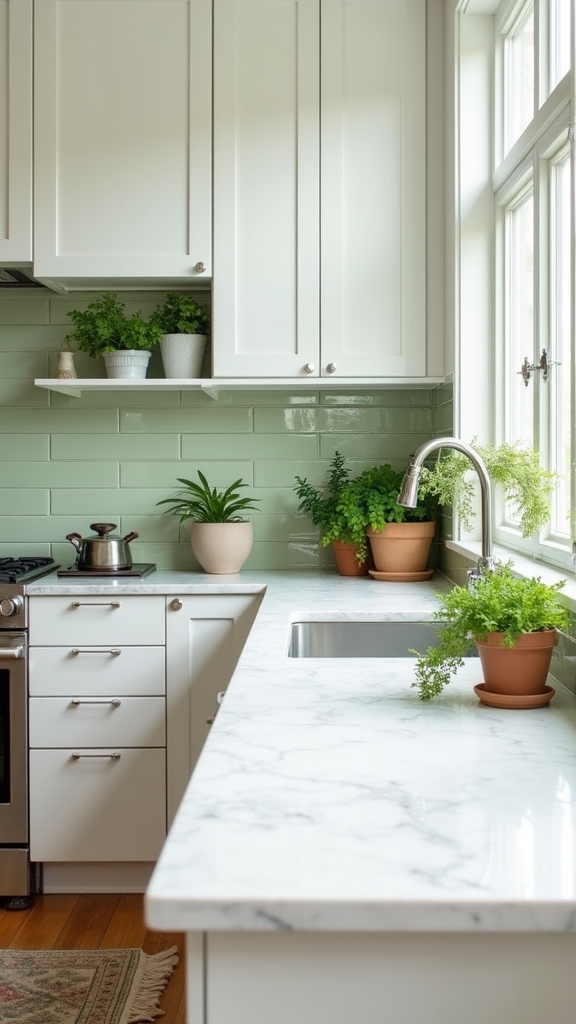
Elevating a white kitchen with a ceiling-height olive green backsplash introduces a striking focal point that amplifies both spatial perception and natural luminosity.
In an airy white kitchen, the vertical expanse of olive green tiles in a glossy finish maximizes light reflection, creating a sense of openness and visual depth.
This design approach leverages the interplay between crisp white cabinetry and the rich, organic hue of the olive green backsplash to establish a modern design that feels simultaneously fresh and welcoming.
The uninterrupted stretch of green tile serves as a cohesive visual connector between upper and lower kitchen elements.
A seamless expanse of green tile elegantly bridges upper and lower kitchen elements, unifying the space with bold, modern cohesion.
Integrating natural wood accents and neutral countertops enhances the overall harmony, grounding the space while maintaining an inviting warmth that is essential in contemporary kitchen environments.
L-Shaped Kitchen With Green Penny Tile Feature Wall
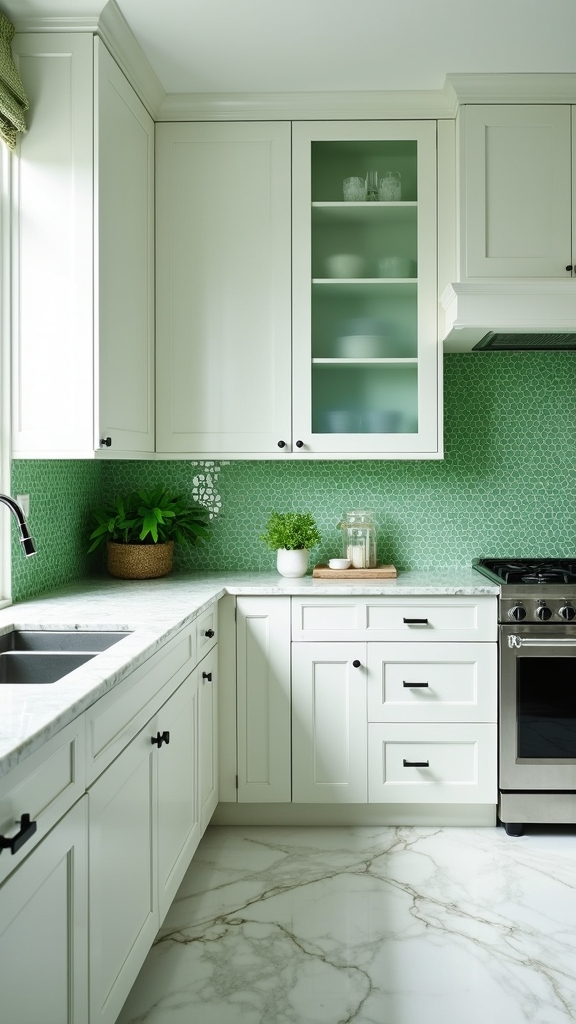
An L-shaped kitchen benefits from a statement-making green penny tile feature wall, introducing both color and tactile interest within a streamlined spatial footprint. The layout’s inherent efficiency is complemented by the reflective quality of white cabinetry, allowing the vibrant tile to anchor the design without overwhelming the space. This approach strategically maximizes openness and functionality while delivering a visually compelling focal point. Incorporating light greige cabinets can enhance room illumination, optimizing space while providing a sophisticated backdrop that complements the vibrant green tiles.
Statement-Making Penny Tile Wall
A green penny tile feature wall immediately commands attention in an L-shaped kitchen, anchoring the layout with a bold, contemporary accent.
The juxtaposition of green penny tiles against crisp white cabinetry establishes a dynamic focal point, while the glossy, rounded surfaces introduce texture and light reflection.
Expert designers leverage this interplay to modernize the kitchen, infusing vibrancy and natural energy.
The feature wall’s adaptability allows for nuanced customization, adapting to diverse shades of green and layout patterns.
This approach guarantees visual cohesion and a tailored aesthetic that harmonizes with the overarching design intent.
- Green penny tiles deliver tactile interest and visual depth
- Glossy finish enhances light, brightening the kitchen space
- Contrasting white cabinetry underscores the feature wall’s impact
- Customizable tile patterns modernize and personalize the overall look
Space-Enhancing L-Shaped Layout
Skillful spatial planning transforms the L-shaped kitchen into an efficient culinary environment, where the integration of a green penny tile feature wall amplifies both form and function.
The L-shaped kitchen layout maximizes corner space, providing a seamless work triangle that supports ergonomic cooking and prep routines. When paired with white cabinets, the green penny tiles or gray green backsplash tiles become a visually compelling focal point, injecting energy and contrast without overwhelming the space.
This configuration offers generous counter space and storage, accommodating both compact and expansive kitchens. Strategically positioning the green tile feature wall enhances natural light reflection, fostering an open, inviting atmosphere.
The interplay of crisp white cabinetry and vibrant green tile establishes a balanced, modern aesthetic, while optimizing workflow and spatial efficiency.
Organic Modern Kitchen With Textured Green Tile
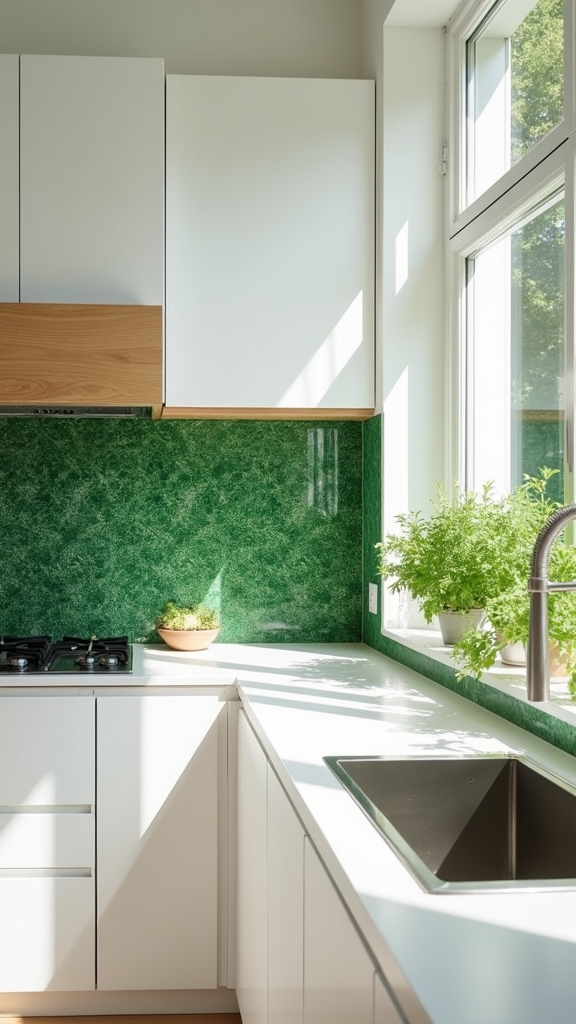
By integrating textured green tile into a primarily white kitchen, designers achieve an organic modern aesthetic that balances serenity with visual intrigue.
The interplay between green tiles, white cabinetry, and natural wood finishes introduces a refined yet approachable palette, underscoring a connection to nature.
Utilizing textured surfaces—such as handmade zellige or glazed ceramic—elevates tactile interest and artisanal quality while supporting a sustainable ethos.
Varying shades of green within the tilework further enhance depth and cohesion, harmonizing with stone and timber accents for a unified spatial experience.
Layer textured green tiles as a backsplash for dynamic visual movement.
Pair white cabinetry with natural wood shelving for balanced warmth.
Select artisanal tile finishes to emphasize unique, handcrafted appeal.
Integrate organic modern materials—stone, wood, and ceramic—for holistic cohesion.
The color psychology of green evokes calmness and sophistication, making it an ideal choice for creating a serene kitchen environment.
Minimalist Mosaic Green Tile in a Compact White Kitchen
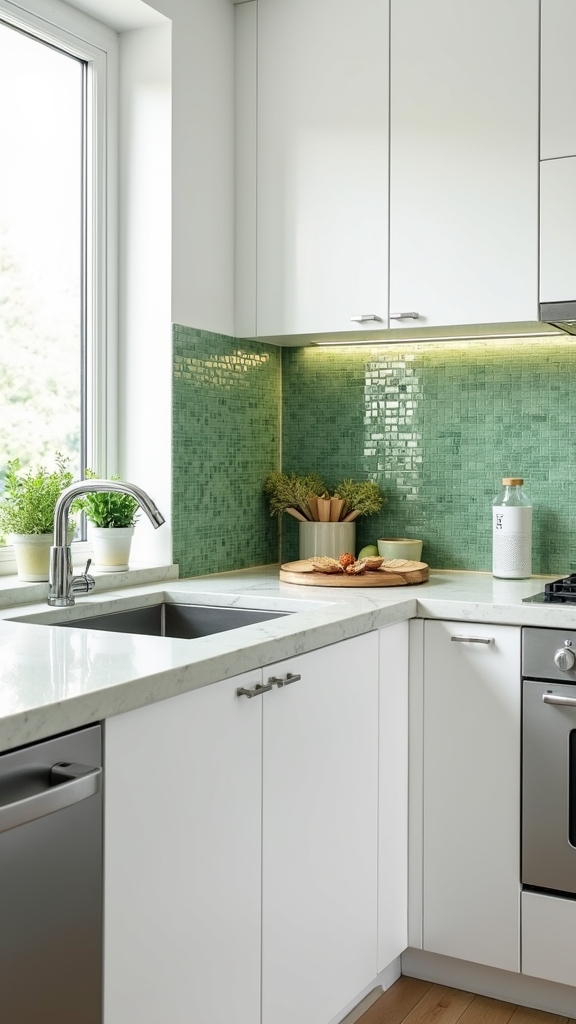
When integrated thoughtfully into a compact white kitchen, minimalist mosaic green tile serves as a visually compelling backsplash that establishes a dynamic yet restrained focal point. The use of small-format tiles introduces subtle texture and a spectrum of green hues, maximizing light reflection and enriching the sense of natural beauty. This strategic contrast between crisp white cabinetry and vibrant green tile achieves a harmonious visual balance, ideal for limited spaces. The minimalist mosaic approach avoids visual clutter, instead offering intricate detail without overwhelming the kitchen’s proportions. The following table outlines key considerations in this design:
| Element | Effect | Guidance |
|---|---|---|
| Tile Scale | Adds depth | Opt for small-format mosaics |
| Color Variation | Enhances natural feel | Mix multiple green shades |
| Placement | Maximizes impact | Focus on backsplash areas |
Rustic White Kitchen With Deep Green Geometric Tiles
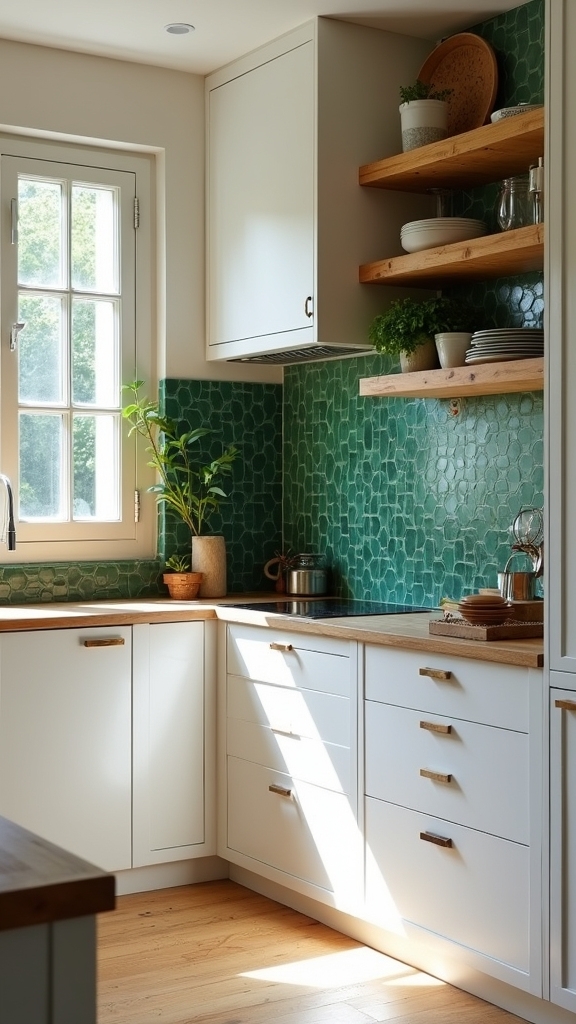
A thoughtfully curated rustic white kitchen gains striking visual depth through the integration of deep green geometric tiles along the backsplash. This combination leverages the crisp brightness of white cabinetry with the grounding presence of deep green tiles, resulting in a harmonious interplay of contrast and texture. The geometric tiles serve as a dynamic focal point, their pattern introducing both rhythm and visual intrigue while enhancing the kitchen’s natural beauty. High-quality ceramic or porcelain options guarantee practicality without compromising on aesthetic value. Warm wooden accents complement the rustic white kitchen, further enriching the inviting ambiance. Under-Counter Charging Drawers provide a sleek solution for organizing devices out of sight, promoting tidiness and adding sophistication to the kitchen design. Deep green geometric tiles create a bold, natural-inspired backsplash focal point. Rustic white cabinetry maintains a sense of spaciousness and clarity. Durable ceramic or porcelain tiles guarantee longevity and ease of maintenance. Wooden details amplify warmth and rustic charm throughout the space.
Frequently Asked Questions
What Color Goes Well With Green Tiles?
When selecting green tile pairings, experts recommend complementary color schemes featuring neutral tones, nature inspired hues, and thoughtful accent color choices. Warm woods, soft pinks, yellow ochre, and metallics can enhance spatial harmony while highlighting green tile’s organic appeal.
How Do I Add Green to My White Kitchen?
To introduce green to a white kitchen, an expert recommends strategically placing green accent pieces, incorporating potted plants for organic vibrancy, selecting kitchen textiles in green hues, and curating wall art to enhance spatial harmony and visual interest.
What Color Goes With Green in a Kitchen Kitchen Cabinet?
When selecting kitchen color schemes, designers recommend pairing green cabinet styles with neutral tones or contrasting accent colors such as soft pink, ochre, or metallics. Thoughtful green decor accents further enhance spatial balance and uplift overall kitchen aesthetics.
What Color Tiles Go With a White Kitchen?
When selecting tiles for a white kitchen, designers recommend exploring geometric tile patterns, subtle accent colors, and glossy backsplash ideas. For flooring options, natural stone or warm wood-effect tiles provide visual depth while preserving the kitchen’s bright, spacious ambiance.
Conclusion
Incorporating green tiles into a white kitchen offers a sophisticated interplay of color, texture, and form. From herringbone layouts to penny tile feature walls, these design strategies leverage contrast and visual rhythm to enhance spatial perception. Selecting the right shade and finish—glossy emeralds, matte sages, or textured mosaics—enables tailored ambiance, whether aiming for organic warmth or contemporary edge. Thoughtful tile placement boosts white kitchens, transforming them into enduring, nature-inspired focal points within the home.
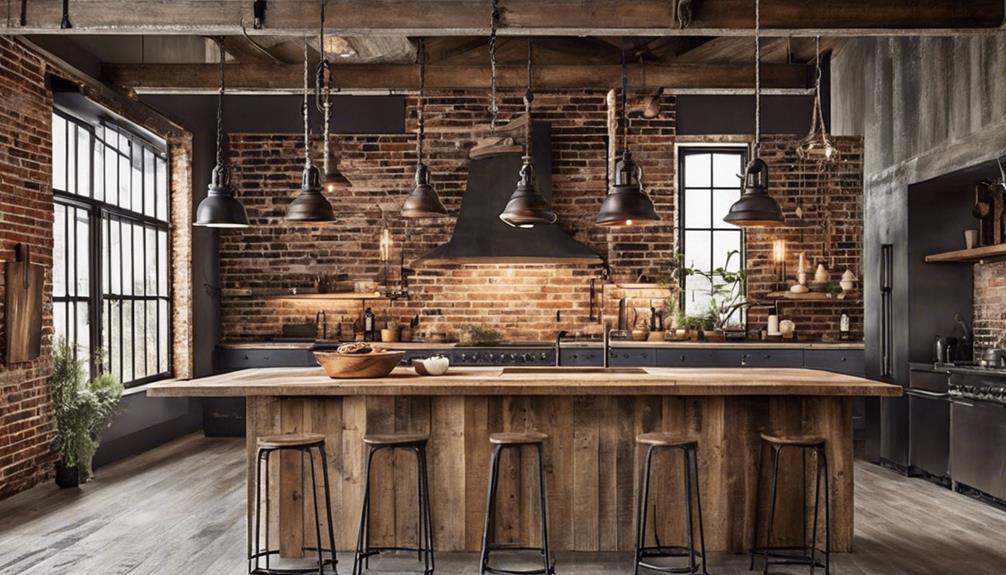
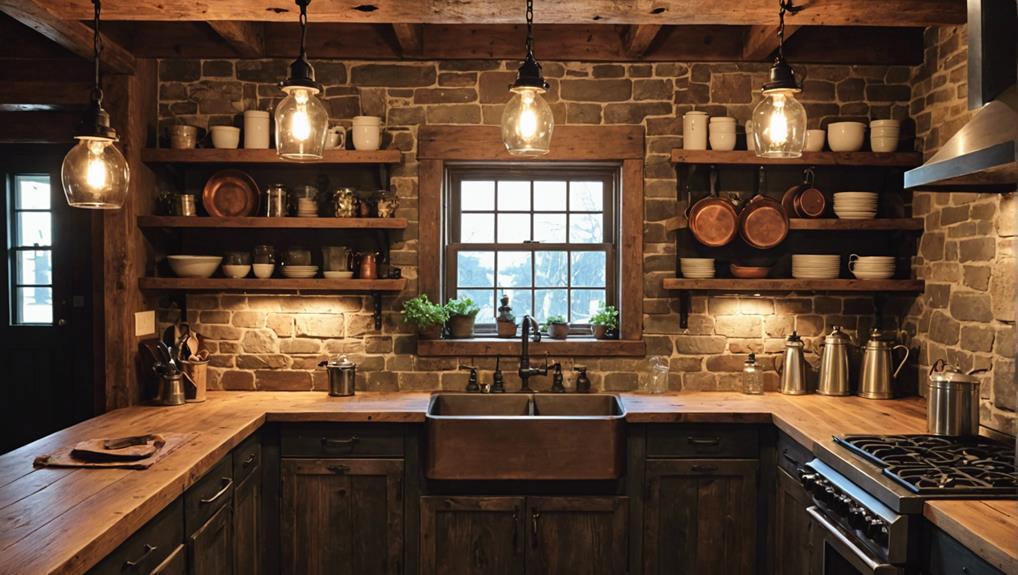
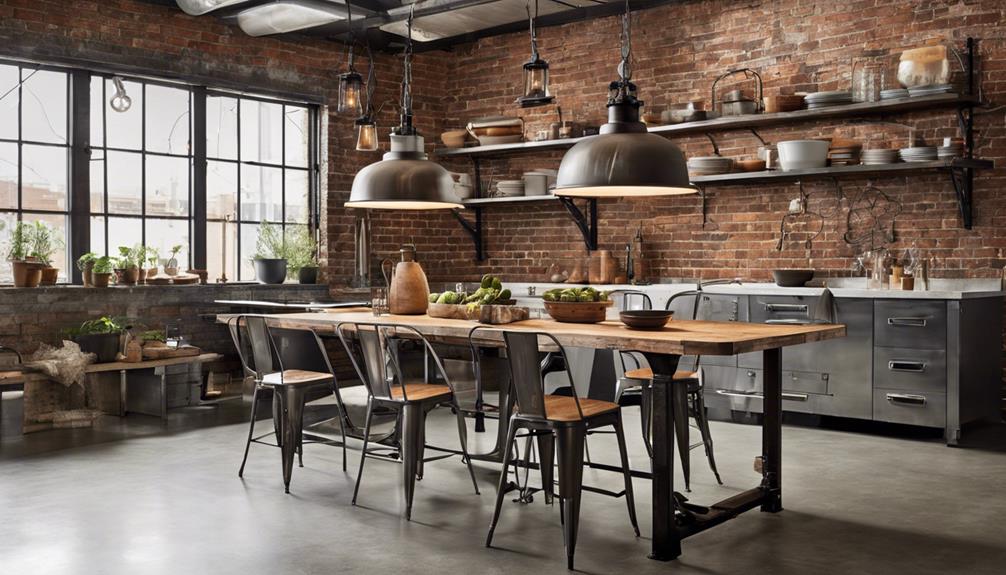
Leave a Reply